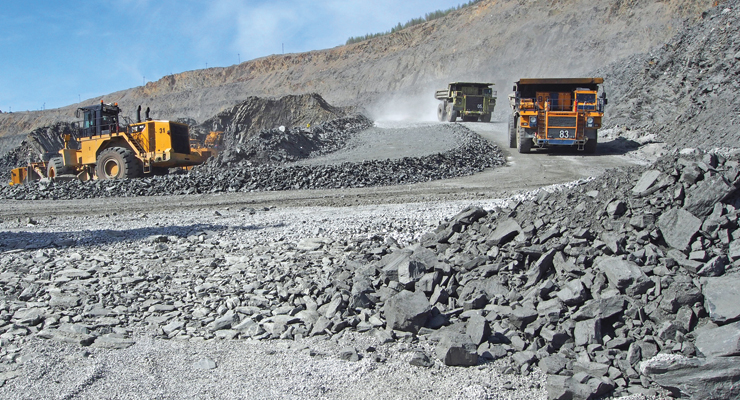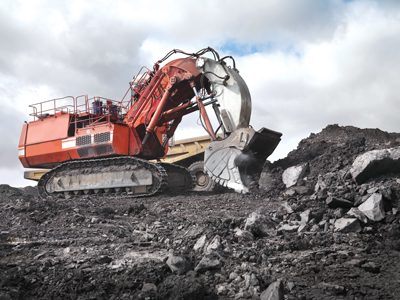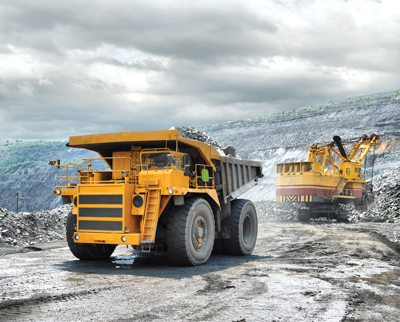 |
| Lubricant programs and services—when delivered from a solutions-oriented approach—can play an important role in advancing productivity in mining operations. |
An interview with Sachin Maheshwari, global strategic marketing, ExxonMobil Fuels & Lubricants
The mining sector faces a host of industry challenges, including fluctuating commodity prices, slimming margins, and increasing expectations from shareholders and national governments.
According to a 2014 Ernst & Young (E&Y) report, these factors have driven mining companies to focus on production volume above all else, which in turn has led to an even greater industry challenge—maintaining productivity levels.
In recent years, productivity growth in the mining sector has been on the decline, and addressing this issue is at the top of almost every mining executive’s agenda. In its report, EY surveyed more than 60 mining executives from around the world, all of whom agreed that productivity is the No. 1 challenge in their industry today.
Lubricant programs and services—when delivered from a solutions-oriented approach—can play an important role in advancing productivity in mining operations. To learn more about the factors contributing to the productivity challenge and the role that lubrication programs can play in delivering productivity, E&MJ spoke with Sachin Maheshwari, global industrial strategic marketing advisor at ExxonMobil Fuels & Lubricants.
First off, why has productivity become such an important goal for the mining industry today?
SM: The mining sector is undergoing significant change, due in large part to rapidly evolving regulatory and market forces. Previously, to be successful, mining companies focused on production volume, working to produce as much as possible to benefit from higher commodity prices.
However, in recent years, commodity prices have fluctuated—meaning that production volume alone no longer guarantees a healthy bottom line. Further, a focus on production volume has many a time led to a reduced focus on maintaining proper performance levels in other important areas, such as equipment and labor efficiency.
As a result, the industry has come to understand that in order to minimize costs and improve profitability, mining operations have to become smarter and more efficient.
How is the mining industry working to achieve these goals and address its productivity gap?
SM: Well, according to the results of a 2014 E&Y survey, which included interviews with more than 60 industry executives, the mining sector is beginning to take a holistic approach to their operations. Specifically, mine operators are moving away from point solutions designed primarily to cut costs and instead moving toward developing and implementing end-to-end business strategies to improve integration between different parts of their business.
In its report, EY stated that there is a need for mining executives to hold a long-term view on strategy, as well as to shift their focus from cost reduction to transformative growth. This means that mining executives need to adopt a clear strategy based on a broad set of values, integration and alignment across the value chain, and standardization of work procedures, among other things.
Of course, when assessing these strategies, executives must consider the numerous factors that comprise an operation, including equipment, labor and organization. Among those factors, mining equipment actually represents a major opportunity for productivity gains within an operation.
That’s interesting. Why does mining equipment represent such a promising opportunity for productivity gain?
SM: In recent years, mining equipment has been the cause of some of the greatest declines in productivity. PricewaterhouseCoopers (PwC) published a report in August 2014 that found that the global mining industry’s surface-mining equipment productivity has declined by 20% over the previous seven years, amounting to billions of dollars of waste.
According to the PwC report, the biggest issue is that while mining operators understand the value of productive equipment, they do not have the right information to underpin their productivity strategies. For example, the PwC report cited payload inefficiencies as being one of the most helpful factors that can be used to assess equipment performance. But, PwC argued, that payload is often an overlooked variable in performance assessments.
From our perspective, one of the most interesting findings from PwC was the importance of equipment maintenance. According to the report, implementing best-in-class maintenance practices can be the difference between achieving acceptable equipment availability rates of 85% and achieving industry-leading availability rates of more than 90%. There are a range of services available to mine operators that can arm them with the right information when it comes to improving equipment maintenance and performance.
For this reason, lubricant products and services—when looked at from a solutions-oriented approach—can play an important role in advancing productivity.
 |
| A recent study indicates that implementing best-in-class maintenance practices can be the difference between achieving acceptable equipment availability rates of 85% or reaching industry-leading availability rates of more than 90%. |
So, how can lubricant products and services help deliver productivity gains?
SM: In working with mining companies around the world, we’ve seen the wide range of tools and machinery involved in operations, which range from processing equipment to off-highway applications. This range of equipment often leads operators to consider just lubricants for specific applications rather than building an overall maintenance program to maximize the productivity of the entire mining operation.
However, with extreme and heavy load conditions commonplace in the mining sector, comprehensive lubrication and maintenance strategies that address the entire operation are required to minimize inefficiencies and optimize equipment performance.
In fact, this comprehensive maintenance approach is in line with the industry strategy outlined by EY—namely, the need for end-to-end solutions. Currently, equipment maintenance practices often vary across operations, and even within a mining operation, equipment is not necessarily maintained with an operation-wide program. By addressing equipment maintenance holistically—using a solutions-driven approach—mine operators can significantly advance productivity.
ExxonMobil has a lot of expertise in this area. With this approach in mind, our team has worked to develop a broad portfolio of products and services that help mining operators better protect and maintain their equipment across their entire operation, greatly simplifying an often complex logistical issue.
For example, we built a range of data-based services, such as oil analysis programs, which can help operators improve the effectiveness of their lubrication programs and achieve overall equipment maintenance solutions to optimize the performance of their operations.
Can you explain in more detail how these services help mining operators improve productivity?
SM: As the EY survey report and the PwC findings demonstrate, the need for mine operators to simplify maintenance practices has never been greater. This is where lubricant services—when introduced as part of a comprehensive lubricant solution—can help.
For example, one of our leading services is Signum Oil Analysis, a lubrication service that provides reviews and documentation support to validate used oil analysis results. Signum also helps explain and guide implementation of necessary steps, ensuring customers fully understand the used oil analysis and can take proper actions to keep their operation safe and productive.
Most importantly, Signum enables customers to identify high-level trends not typically seen when viewing individual sample reports, with summaries that help customers understand the health of their equipment fleet detailed by alarm, equipment type, product in use, application and operation. Essentially, the service offers a central dashboard for lubrication and equipment maintenance needs.
Another example of a beneficial service is our Planned Engineering Services (PES) platform, which is a planned, proactive approach to lubrication maintenance that helps customers maintain maximum availability of equipment and operate mines at lower unit cost. This is accomplished through implementing lubrication solutions and establishing effective controls based on our long-standing knowledge of lubrication, maintenance and manufacturing processes.
How does Planned Engineering Services differ from lubricant and equipment monitoring?
SM: PES involves on-site visits from our mining lubrication experts to effectively identify suffering points and potential benefits, analyze the situation, identify causes and recommend solutions to solve the problem or improve the situation. Once the recommended steps are taken, our team documents the cost benefits realized and presents them to the customer.
PES is a great example of a service that provides mine operators with a comprehensive, application-specific solution to address their productivity challenge and ensures that their efforts to boost productivity are continuously supported. When utilized in conjunction with other services and high-quality lubricant products, it helps optimize equipment maintenance across entire operations, from start to finish.
 |
| It’s important for mine companies to partner with lubricant suppliers that are able to understand and account for the diverse needs of an operation. |
You mentioned other services. Outside of lubricant monitoring and engineering support, what services are available to mine operators to advance productivity?
SM: There are a whole range of services available to the mining industry, and in working with mining companies around the world, we have seen first-hand how these services can not only help enhance equipment performance, but also deliver critical safety, financial and sustainability-related benefits.
In addition to oil analysis programs and PES, other mining-specific technical services include shovel inspection and mill open-gear inspection. Valuable business service offerings include storage and handling studies, contamination control assessments, emergency response, oil drain interval optimization and customer training, among others.
How can mine operators work to develop and implement lubricant-driven equipment maintenance strategies?
SM: Most importantly, partner with a lubricant supplier that understands your business from top to bottom. In order to help implement a comprehensive lubrication program at a mining operation, or across multiple operations, mine operators require the expertise of partners who understand their sector and the range of equipment that is used.
For example, mine operations require the use of both industrial lubricants and commercial vehicle lubricants. Industrial lubricants help power and protect process equipment, while commercial vehicle lubricants protect the engines of heavy equipment such as excavators, dump trucks and loaders involved in the transportation of mined goods.
So, while the specific combination of lubricant products and services used will vary based on each mine operation’s specific needs, it’s imperative for mine companies to partner with lubricant suppliers that are able to understand and account for the diverse needs of an operation. Also, working with a global leader benefits customers in that we are able to provide expertise based on our experience of working with leading equipment builders around the world, which has provided us with a comprehensive understanding of their equipment specifications and of international standards.
How important do you think equipment maintenance and lubrication best practices will become for mine operators moving forward?
SM: In short, very important. It’s already clear that the mining industry is beginning to understand that advancing productivity requires a comprehensive, solutions-oriented approach to equipment maintenance, and more specifically to lubricant selection and analysis.
We’ve already seen this first-hand. Our experience has shown that when mining companies consider lubrication as an integral part of their operations and technology development rather than as an interchangeable commodity, they can generate substantial benefits.
And so, as mine operators begin to implement end-to-end solutions to transform their businesses, comprehensive equipment maintenance programs, driven heavily by lubricant products and services, will have an important role to play.









